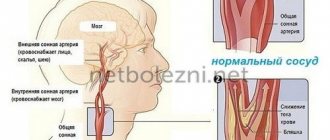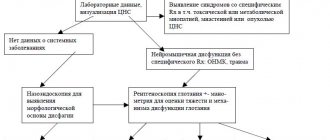A lump in the throat during neurosis is the first signal that malfunctions are occurring in the functioning of the nervous system. Patients who have problems with swallowing and sore throat seek help from many specialists, but few of them associate these symptoms with psychosomatics. “Pharynx neurosis” refers to a pathology that affects the funnel-shaped canal - the link between the mouth and the esophagus.
Symptoms that something is wrong with your throat
The feeling of a lump in the throat may be accompanied by a “soreness” in the throat, a feeling of incomplete inhalation, difficulty swallowing, discomfort in the neck and chest, a burning sensation or a sensation of a foreign body, although there are no changes when palpated (nothing is enlarged, not deformed, not inflamed).
A “lump” that appears once should not cause concern, since it is most likely a one-time reaction of the body to stress, overwork, or excitement of the nervous system.
If this phenomenon recurs, you should consult a doctor, as this feeling can become a painful symptom, “overgrown” with other manifestations: a feeling of a foreign body in the oropharynx, sleep disturbances, anxiety, loss of appetite and disruption of normal swallowing, surges in blood pressure and sensations of heart failure , diarrhea or constipation.
As a rule, timely and adequate treatment completely eliminates the unpleasant symptom.
Diagnostics
A thorough examination and an equally detailed collection of anamnesis and complaints are the most important components of the diagnosis of hyperventilation syndrome. The disease always causes a large number of complaints about the functioning of certain systems and organs, which can immediately lead to the idea of hyperventilation syndrome. However, a final diagnosis can only be made if organic diseases of the organs and systems that the patient complains about are excluded. To confirm their absence, additional procedures are prescribed: ultrasound of the abdominal organs, ECG, ultrasound of the heart, spirography and others.
Careful questioning of the patient usually reveals certain anxieties, high emotional stress and other changes. This is called a positive psychogenic analysis, which also leads the doctor to think about hyperventilation syndrome.
The disease can be detected using a simple and free method that does not require special equipment. The patient needs to breathe frequently and deeply for 5 minutes. If hyperventilation syndrome is truly present, then the symptoms will begin to manifest themselves. Since when symptoms of the disease appear, the amount of carbon dioxide in the exhaled air and blood decreases, after the onset of symptoms the patient needs to breathe air with a 5% carbon dioxide content (in a clinical setting) or breathe into a plastic bag. This will help relieve symptoms.
Medical researchers have developed a unique questionnaire, the results of which can diagnose the disease in 9 out of 10 cases.
The diagnosis of hyperventilation syndrome cannot be made on the basis of one specific symptom and the results of additional studies that refute the problem with the disturbing organ or system. After all, disorders of the respiratory system may also indicate the presence of a number of other diseases, much more terrible (heart failure, bronchial asthma, and so on). Only the doctor’s individual approach to the patient, combined with modern research techniques and a complete comprehensive examination, will help make the only correct diagnosis.
Causes of an unpleasant lump in the throat
- Overwork.
- Severe or long-term stress. Nervous tension.
- Neuroses and neurotic reactions.
- Depression.
- Anxiety disorder (phobias, panic attacks, generalized anxiety disorder, etc.)
- Psychosomatic diseases.
- Schizotypal disorder, schizophrenia.
- Consequences of organic damage to the nervous system after trauma. infections, strokes, heart attacks, etc.
- Diseases of internal organs (hyperthyroidism, thyroiditis, tonsillitis, spinal osteochondrosis, hiatal hernia, obesity or cachexia).
- Allergic reactions.
- Poisoning.
Causes
The development of the disease can be influenced by a number of factors, which are divided into 4 subgroups:
- Diseases of the nervous system that are organic in nature;
- Psychogenic factors: anxiety and stress (chronic), fears, neuroses, hysteria, neurasthenia;
- Lack of magnesium, calcium and other metabolic disorders, as well as intoxication;
- Various diseases: hypertension, rheumatoid arthritis, diabetes and others.
Psychogenic factors are the most common. It has been proven that hyperventilation syndrome very often overcomes people who, in childhood and adolescence, had to periodically observe respiratory disorders. There are a lot of examples: suffocation of drowning people, asthma, and so on.
Hyperventilation syndrome from a neurological point of view is a kind of failure of the “inhale-exhale” program. The alternation of inhalation and exhalation becomes unstable, resulting in excessive oxygen supply to the lungs. This process starts from the brain stem, where excessive excitability of the respiratory center occurs. All this leads to increased acidity and a decrease in the amount of carbon dioxide in the blood, and mineral imbalance occurs. Changes occurring in the body cause the symptoms of this disease.
Who to contact if you have a lump in your throat
The feeling of a lump in the throat is treated by a psychotherapist or psychiatrist. During the consultation, the doctor will assess the condition and determine the amount of assistance needed.
Help can be obtained in any clinic where there is a license to provide assistance in psychotherapy, psychiatry and neurology and where a psychiatrist or psychotherapist conducts an appointment.
ROSA Clinic
is a specialized and licensed clinic that provides assistance for all types of disorders accompanied by a feeling of a lump in the throat.
Our specialists
are ready to come to your home for consultation; you can also see a doctor in our clinic.
Treatment is most often carried out at home. If necessary, it is possible to be hospitalized in our own hospital, equipped with modern diagnostic equipment and where it is possible to carry out active treatment.
General picture of the disorder
The main symptom of the disorder is the appearance of somatic symptoms affecting one or more organ systems.
The pathological manifestations are multiple, reminiscent of the clinical picture of a separate disease, but are characterized by blurriness, uncertainty, and rapid variability. A peculiarity of the presentation of complaints by patients is a special dramatism. Patients present symptoms emotionally vividly, exaggeratedly, using all kinds of epithets. They visit a huge number of doctors of various specialties and require examinations. When examinations refute the presence of physical pathology, the patient resists this news, is confident in the examination’s error and continues further vigorous diagnostic and treatment activities. Patients often spend years on “treatment” before a correct diagnosis is made.
Such people are quite sensitive to their own feelings, tend to exaggerate them, and often call an ambulance and are hospitalized. Numerous examinations and ineffective treatment fuel patients’ confidence in the presence of the disease. This situation causes distrust in individual specialists and medicine itself.
How is the feeling of a lump in the throat treated?
Treatment is determined by the causes and mechanism of development of the disease and is selected individually for each patient.
For a recent and non-severe condition
treatment is carried out on an outpatient basis: the doctor conducts a psychotherapeutic session, prescribes medications that the patient takes at home and periodically comes for follow-up consultations.
For moderate severity
- treatment in a day hospital is recommended: daily treatment procedures are carried out (drug infusions, physiotherapy, etc.), which take an hour and a half, but the patient lives at home and goes about his usual business. The average course of a day hospital is about 10 days.
In severe condition
hospitalization in a hospital is recommended. Due to intensive treatment, the condition can be stabilized already in the first hours of stay. The average length of hospital stay is 10 days (from 5 to 30 days depending on the severity of the condition and the body’s recovery abilities).
Main methods of treatment:
- Psychotherapy.
- Drug treatment (pharmacotherapy).
- Physiotherapy.
- Massage and manual therapy.
- Diet therapy.
- Biofeedback therapy.
Formation mechanism
The autonomic nervous system is the main regulator of the activity of internal organs, blood vessels and glands. Therefore, this system is often called visceral. The ANS regulates the functioning of organs in accordance with changes in environmental conditions.
The autonomic system is represented by two departments: sympathetic and parasympathetic, which have mutually opposite effects:
- The sympathetic nervous system mobilizes the body's defense reactions, preparing it for vigorous activity. Intensifies metabolism, increases arousal;
- The parasympathetic nervous system restores wasted energy. Stabilizes the body's condition. Supports its work during sleep.
Both departments have opposite effects on internal organs.
| Organ | Sympathetic NS | Parasympathetic NS |
| Heart | Tachycardia, increased force of contractions | Bradycardia, decreased force of contractions |
| Arteries | Constriction of organs, dilation of muscle vessels | Dilates blood vessels of the genitals and brain; narrows the coronary and pulmonary arteries. |
| Intestines | Inhibits peristalsis and enzyme synthesis | Enhances peristalsis and enzyme synthesis |
| Pulmonary system | Bronchial dilatation, hyperventilation of the lungs | Narrowing of the bronchi, decreased ventilation |
| Bladder | Relaxation | Reduction |
| Salivary glands | Depresses work | Stimulates saliva secretion |
| Pupil | Expands | Narrows |
The opposite influence of systems with balanced work helps to balance the condition of the internal organs. The ANS is not subject to human will. For example, we cannot make the heart stop beating. But vegetative activity is subject to the influence of stress factors. This is easy to check. Remember how your heart begins to “rumble” when you are scared. The mouth becomes dry, intestinal colic appears, and the urge to urinate increases. This activates the sympathetic department, mobilizing the body's protective resources.
The fear went away - the heart calmed down, breathing returned to normal. This is the merit of parasympathetics.
Problems begin when the activities of both departments are separated. There are several reasons for this imbalance:
- heredity;
- hormonal changes;
- chronic stress;
- powerful simultaneous stress impact;
- overwork;
- chronic intoxication;
- alcohol abuse;
- radiation;
- action of high temperatures.
Disharmony in the activity of the ANS triggers the formation of somatoform dysfunction of the autonomic nervous system. Vegetative control over organs decreases. Their work is disrupted, giving rise to painful symptoms, but there are no organic changes. The main reason is stress.
Somatic symptoms are a way of experiencing stressful situations at a physiological level. This was also discussed by Adler, who developed the concept of the symbolic language of organs. The theory said: organ systems specifically mirror mental processes.
Which categories of people are more likely to experience cardioneurosis?
The key reason for the development of heart neurosis is the effect of a stressful situation on the body. The first question that a psychiatrist asks a patient with suspected cardiac neurosis concerns the presence of problems in life and recent psychological trauma experienced. Perhaps a person’s loved one has died or fallen ill, problems have arisen in school or at work, or financial difficulties have arisen.
Heart neurosis often occurs in people in adolescence against the background of hormonal changes and a negative stressful environment. In most cases, the disorder occurs in women and girls.
The problem with neurosis is that a person, when it manifests itself for a long time, considers himself truly sick. He spends a lot of time, effort and financial resources traveling to doctors and trying to establish the correct diagnosis. But the solution to the problem lies exclusively in psychological treatment using properly selected drugs and techniques.
Somatic symptoms of dysfunction
The main target organs of somatoform dysfunction are the heart, lungs, and digestive tract.
Frequent complaints are heart pain that is not clearly localized. Cardialgia is attributed to a different character: stabbing, cutting, aching, squeezing, pressing, “scorching.” The intensity is variable: from unpleasant to painful, depriving sleep. The pain can persist for several minutes or hours and affects the area of the shoulder blade, arm, and right side of the chest.
The cause of pain is fatigue, anxiety, and weather changes. These appear after physical activity. This circumstance is important to take into account when differentiating VNS DM from angina pectoris, characterized by the appearance of pain during physical activity.
Cardialgia is accompanied by anxiety, restlessness, weakness, and lethargy. There is a feeling of lack of air, internal trembling, tachycardia, increased sweating.
You may feel a change in rhythm. Tachycardia is usually limited to 90-140 beats per minute, but is situational. It is provoked by changes in body position, drinking strong tea, coffee, alcoholic beverages or smoking. It goes away quickly. Often there is a feeling of fading, interruptions in the heart.
Pressure during somatoform dysfunction rises to reasonable limits, changes many times during the day, at night and stabilizes in the morning.
An indicative symptom of the respiratory system is shortness of breath, caused by a state of emotional stress. There is a pressing sensation in the chest. It's hard to take a breath. The patient experiences shortness of breath. Experiencing this, a person suffering from somatoform dysfunction constantly ventilates the premises and feels discomfort when being in closed spaces.
Patients are accompanied by frequent, shallow breathing, interrupted by periodic deep sighs. Attacks of neurotic cough occur.
Changes in the digestive system are characterized by:
- epigastric pain that occurs regardless of food intake;
- difficulty swallowing;
- stool disorder. The patient suffers from constipation or diarrhea;
- poor appetite;
- belching, heartburn, vomiting;
- improper salivation.
Somatoform dysfunction of the autonomic nervous system may be accompanied by hiccups, which are intrusive and quite loud.
VNS diabetes provokes urinary disorders. The urge becomes more frequent, and there is a need to empty the bladder in the absence of a toilet. Difficulty urinating in public toilets is typical.
Other signs of the disorder include low-grade fever, joint pain, fatigue, and decreased performance. Patients often suffer from insomnia, they become irritable and excitable.
It should be noted that the symptoms of somatoform dystonia are provoked by stress, nervous strain and are not caused by circumstances that cause the manifestations of an actual disease.
Somatoform dysfunction of the ANS has the following features:
- multiplicity of symptoms;
- non-standard nature of the symptoms shown;
- strong emotional reaction;
- discrepancy with the results of objective diagnostics;
- too intense severity of symptoms or, conversely, lack of brightness of symptoms;
- lack of response to standard provoking factors;
- futility of somatotropic therapy.









